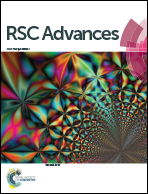Preparation of chrome-tanned leather shaving-based hierarchical porous carbon and its capacitance properties
Abstract
Based on the complexes formed by the original Cr(III) in chrome-tanned leather shavings and the carboxyl groups in collagen as raw materials, a chromium oxide-carbon composite material was formed by the high-temperature carbonization of chromium-tanned leather shavings, followed by the leaching of chrome oxide and activation by KOH. By this method, the hierarchical porous carbon with a high surface area doped with oxygen and nitrogen was prepared. The forming process of the hierarchical porous structure is discussed in detail. Through adjusting the mass ratio of KOH to carbon during the activation process, with a mass ratio of 2, the chromium-tanned leather shavings-based hierarchical porous carbon (called CTSHPC-2) was prepared with an optimal specific surface area (3211 m2 g−1) and a large volume ratio of mesopores to macropores (61.9%) as well as abundant oxygen (13.92 at%) and nitrogen (3.58 at%) functional groups. The results showed that CTSHPC-2 obtained a high specific capacitance of 335.5 F g−1 at a current density of 0.5 A g−1. In addition, it had higher rate performance, low resistance, and better cycle stability. Even when the current density is 10 A g−1 over 5000 cycles, the specific capacity retention rate is 93.5%. Therefore, CTSHPC-2 is a promising electrode material for supercapacitors.



 Please wait while we load your content...
Please wait while we load your content...